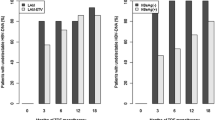Abstract
Background/Aims
Lamivudine (LAM) has been extensively used to treat hepatitis B, but high incidence of drug resistance has required rescue studies. We validated the optimum treatment strategy for LAM-resistant patients by means of a comparative study of add-on adefovir (ADV) and a switch to entecavir (ETV).
Methods
We assessed the virologic response in consecutive LAM-resistant patients who received add-on ADV or a switch to ETV.
Results
The mean reduction of serum hepatitis B virus (HBV) DNA levels was significantly less in the ETV group than in the add-on ADV group (−3.45 vs. −4.17; P = 0.047 at week 24 and −3.81 vs. −4.68 log10 IU/mL; P = 0.044 at week 48). Achievement of undetectable HBV DNA was significantly lower in the ETV group than in the add-on ADV group (P = 0.043). Multivariate analysis showed that add-on ADV, baseline HBV DNA levels, and initial virologic response were significant predictors of HBV DNA negativity (adjusted OR, 2.582; P = 0.008, 0.304; P = 0.001, and 5.928; P = 0.001). Virologic breakthrough was observed for 12 patients, in the ETV group only.
Conclusions
Add-on ADV was more effective and durable than ETV as rescue therapy. Therefore, add-on ADV might be the preferred strategy for LAM-resistant patients who need long-term antiviral treatment.



Similar content being viewed by others
Abbreviations
- ADV:
-
Adefovir
- ALT:
-
Alanine aminotransferase
- CHB:
-
Chronic hepatitis B
- LAM:
-
Lamivudine
- ETV:
-
Entecavir
- HBeAg:
-
Hepatitis B envelope antigen
- HBV:
-
Hepatitis B virus
- HCC:
-
Hepatocellular carcinoma
- HCV:
-
Hepatitis C virus
- IVR:
-
Initial virologic response
- TFV:
-
Tenofovir
- YMDD:
-
Tyrosine-methionine-aspartate-aspartate
References
Lavanchy D. Hepatitis B virus epidemiology, disease burden, treatment, and current and emerging prevention and control measures. J Viral Hepat. 2004;11:97–107.
Chen CJ, Yang HI, Su J, et al. Risk of hepatocellular carcinoma across a biological gradient of serum hepatitis B virus DNA level. JAMA. 2006;295:65–73.
Iloeje UH, Yang HI, Su J, et al. Predicting cirrhosis risk based on the level of circulating hepatitis B viral load. Gastroenterol. 2006;130:678–686.
Leung NW, Lai CL, Chang TT, et al. Extended lamivudine treatment in patients with chronic hepatitis B enhances hepatitis B e antigen seroconversion rates: results after 3 years of therapy. Hepatol. 2001;33:1527–1532.
Mommeja-Marin H, Mondou E, et al. Serum HBV DNA as a marker of efficacy during therapy for chronic HBV infection: analysis and review of the literature. Hepatol. 2003;37:1309–1319.
Locarnini S, Mason WS. Cellular and virological mechanisms of HBV drug resistance. J Hepatol. 2006;44:422–431.
Andreone P, Gramenzi A, Cursaro C, et al. High risk of hepatocellular carcinoma in anti-HBe positive liver cirrhosis patients developing lamivudine resistance. J Viral Hepat. 2004;11:439–442.
Di Marco V, Marzano A, Lampertico P, et al. Clinical outcome of HBeAg-negative chronic hepatitis B in relation to virological response to lamivudine. Hepatol. 2004;40:883–891.
Lok AS, McMahon BJ. Chronic hepatitis B. Hepatol. 2007;45:507–539.
Colonno RR RJ, Pokornowski K, Baldick CJ, et al. Four year assessment of entecavir resistance in nucleoside-naïve and lamivudine refractory patients. J Hepatol. 2007;46:s204. (abstract).
Sherman M, Yurdaydin C, Simsek H, et al. Entecavir therapy for lamivudine-refractory chronic hepatitis B: improved virologic, biochemical, and serology outcomes through 96 weeks. Hepatol. 2008;48:99–108.
Peters MG, Hann Hw H, Martin P, et al. Adefovir dipivoxil alone or in combination with lamivudine in patients with lamivudine-resistant chronic hepatitis B. Gastroenterol. 2004;126:91–101.
Yatsuji H, Suzuki F, Sezaki H, et al. Low risk of adefovir resistance in lamivudine-resistant chronic hepatitis B patients treated with adefovir plus lamivudine combination therapy: two-year follow-up. J Hepatol. 2008;48:923–931.
Idilman R, Kaymakoglu S, Oguz Onder F, et al. A short course of add-on adefovir dipivoxil treatment in lamivudine-resistant chronic hepatitis B patients. J Viral Hepat. 2009;16:279–285.
Leemans WF, Flink HJ, Janssen HL, et al. The effect of pegylated interferon-alpha on the treatment of lamivudine resistant chronic HBeAg positive hepatitis B virus infection. J Hepatol. 2006;44:507–511.
Ryu HJ, Lee JM, Ahn SH, et al. Efficacy of adefovir add-on lamivudine rescue therapy compared with switching to entecavir monotherapy in patients with lamivudine-resistant chronic hepatitis B. J Med Virol. 2010;82:1835–1842.
Kim HJ, Park JH, Park DI, et al. Rescue therapy for lamivudine-resistant chronic hepatitis B: comparison between entecavir 1.0 mg monotherapy, adefovir monotherapy and adefovir add-on lamivudine combination therapy. J Gastroenterol Hepatol. 2010;25:1374–1380.
Tenney DJ, Levine SM, Rose RE, et al. Clinical emergence of entecavir-resistant hepatitis B virus requires additional substitutions in virus already resistant to Lamivudine. Antimicrob Agents Chemother. 2004;48:3498–3507.
Villet S, Ollivet A, Pichoud C, et al. Stepwise process for the development of entecavir resistance in a chronic hepatitis B virus infected patient. J Hepatol. 2007;46:531–538.
Colonno RJ, Rose R, Baldick CJ, et al. Entecavir resistance is rare in nucleoside naive patients with hepatitis B. Hepatol. 2006;44:1656–1665.
Yeon JE, Yoo W, Hong SP, et al. Resistance to adefovir dipivoxil in lamivudine resistant chronic hepatitis B patients treated with adefovir dipivoxil. Gut. 2006;55:1488–1495.
Lee YS, Suh DJ, Lim YS, et al. Increased risk of adefovir resistance in patients with lamivudine-resistant chronic hepatitis B after 48 weeks of adefovir dipivoxil monotherapy. Hepatol. 2006;43:1385–1391.
Baldick CJ, Tenney DJ, Mazzucco CE, et al. Comprehensive evaluation of hepatitis B virus reverse transcriptase substitutions associated with entecavir resistance. Hepatol. 2008;47:1473–1482.
Conflict of interest
None.
Author information
Authors and Affiliations
Corresponding author
Additional information
An erratum to this article can be found at http://dx.doi.org/10.1007/s10620-011-1690-2
Rights and permissions
About this article
Cite this article
Chung, G.E., Kim, W., Lee, K.L. et al. Add-On Adefovir Is Superior to a Switch to Entecavir as Rescue Therapy for Lamivudine-Resistant Chronic Hepatitis B. Dig Dis Sci 56, 2130–2136 (2011). https://doi.org/10.1007/s10620-010-1561-2
Received:
Accepted:
Published:
Issue Date:
DOI: https://doi.org/10.1007/s10620-010-1561-2




